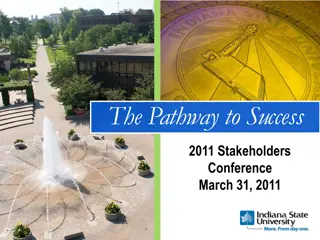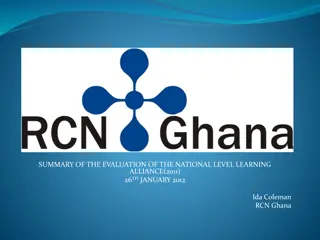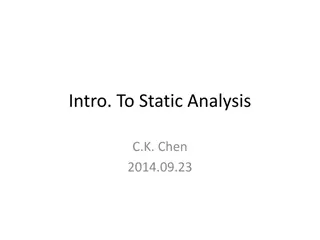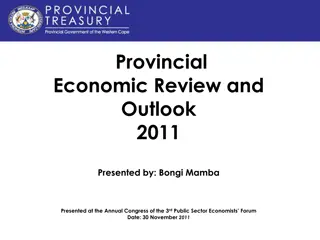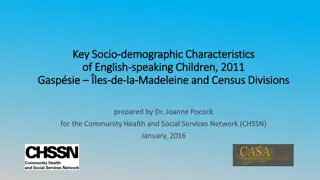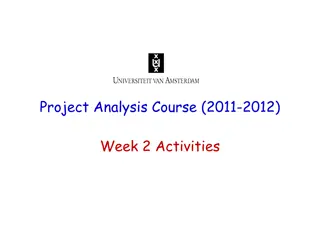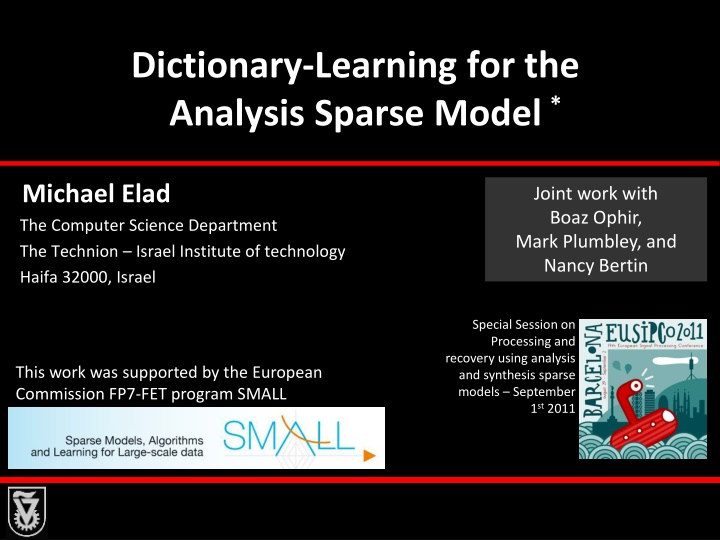
Sparse Model Analysis in Dictionary Learning with Michael Elad
Explore the principles of dictionary learning for analysis sparse models presented by Michael Elad, highlighting the background of synthesis and analysis models, Bayesian perspectives, and the concept of Union-of-Subspaces for generating analysis signals. Discover the basics of the synthesis and analysis models, co-sparsity, co-support, and a Bayesian view of these models.
Download Presentation

Please find below an Image/Link to download the presentation.
The content on the website is provided AS IS for your information and personal use only. It may not be sold, licensed, or shared on other websites without obtaining consent from the author. If you encounter any issues during the download, it is possible that the publisher has removed the file from their server.
You are allowed to download the files provided on this website for personal or commercial use, subject to the condition that they are used lawfully. All files are the property of their respective owners.
The content on the website is provided AS IS for your information and personal use only. It may not be sold, licensed, or shared on other websites without obtaining consent from the author.
E N D
Presentation Transcript
Dictionary-Learning for the Analysis Sparse Model * Michael Elad The Computer Science Department The Technion Israel Institute of technology Haifa 32000, Israel Joint work with Boaz Ophir, Mark Plumbley, and Nancy Bertin Special Session on Processing and recovery using analysis and synthesis sparse models September This work was supported by the European Commission FP7-FET program SMALL 1st 2011
Part I - Background The Synthesis and Analysis Models Dictionary-Learning for the Analysis Sparse Model By: Michael Elad 2
The Synthesis Model Basics m The synthesis representation is expected to be sparse: = 0 k d = d Adopting a Bayesian point of view: Dictionary x Draw the support at random D Choose the non-zero coefficients randomly (e.g. iid Gaussians) Multiply by D to get the synthesis signal Such synthesis signals belong to a Union-of-Subspaces (UoS): = T k k = T x span D D x where T T m This union contains subspaces, each of dimension k. Dictionary-Learning for the Analysis Sparse Model By: Michael Elad 3
The Analysis Model Basics d The analysis representation z is expected to be sparse = 0 x z = p = 0 Co-sparsity: - the number of zeros in z. p Co-Support: - the rows that are orthogonal to x = x x 0 * z Analysis Dictionary If is in general position , thenand thus we cannot expect to get a truly sparse analysis representation Is this a problem? No! 0 d 1. S. Nam, M.E. Davies, M. Elad, and R. Gribonval, "Co-sparse Analysis Modeling - Uniqueness and Algorithms" , ICASSP, May, 2011. S. Nam, M.E. Davies, M. Elad, and R. Gribonval, "The Co-sparse Analysis Model and Algorithms" , Submitted to ACHA, June 2011. = + 2. T * spark d 1 Dictionary-Learning for the Analysis Sparse Model By: Michael Elad 4
A Bayesian View of These Models d Analysis signals, just like synthesis ones, can be generated in a systematic way: = Synthesis Signals Analysis Signals p x Support: Choose the support T (|T|=k) at random Choose T at random Choose the co- support (| |= ) at random z Analysis Dictionary Coef. : Choose a random vector v Orhto v w.r.t. : = x I Generate: Synthesize by: DT T=x v = = Bottom line: an analysis signal x satisfies: s.t. x 0 Dictionary-Learning for the Analysis Sparse Model By: Michael Elad 5
Union-of-Subspaces d Analysis signals, just like synthesis ones, belong to a union of subspaces: = Synthesis Signals Analysis Signals p x What is the Subspace Dimension: k d- How Many Subspaces: m p z Analysis Dictionary k Who are those Subspaces: span span D T Example: p=m=2d: Synthesis: k=1 (one atom) there are 2d subspaces of dimensionality 1 Analysis: =d-1 leads to >>O(2d) subspaces of dimensionality 1 d 1 2d Dictionary-Learning for the Analysis Sparse Model By: Michael Elad 6
The Analysis Model Summary m The analysis and the synthesis models are similar, and yet very different D = d The two align for p=m=d : non-redundant Just as the synthesis, we should work on: x Pursuit algorithms (of all kinds) Design Pursuit algorithms (of all kinds) Theoretical study d Dictionary learning from example-signals Applications = Our experience on the analysis model: z p Theoretical study is harder x Different applications should be considered Dictionary-Learning for the Analysis Sparse Model By: Michael Elad 7
Part II Dictionaries Analysis Dictionary-Learning by Sequential Minimal Eigenvalues 1. B. Ophir, M. Elad, N. Bertin and M.D. Plumbley, "Sequential Minimal Eigenvalues - An Approach to Analysis Dictionary Learning", EUSIPCO, August 2011. R. Rubinstein and M. Elad, A k-SVD Dictionary Learning Algorithm for the Co- sparse Analysis Model" , will be submitted (very) soon to IEEE-TSP .... 2. Dictionary-Learning for the Analysis Sparse Model By: Michael Elad 8
Analysis Dictionary Learning The Signals = X A We are given a set of N contaminated (noisy) analysis signals, and our goal is to recover their analysis dictionary, I N = + = = 2 jy x v , s.t . x 0 , v~ N 0 , j j j j = j j 1 Dictionary-Learning for the Analysis Sparse Model By: Michael Elad 9
Lets Find a Single Row w from Observations: 1. Any given row is supposed to be orthogonal to ~ signals. 2. If we knew S, the true set of examples that are orthogonal to a row w, then we could approximate w as the solver of Set w to a random normalized vector N/p Compute Inner-Products |wTY| ( ) j S 2 T c N/p Set S to be the set of examples with the smallest inner-product min w y j = w 1 2 We shall seek w by iteratively solving the above for w and S alternately. Update w to be the eigenvector corresponding to the smallest eigenvalue of YSYST Dictionary-Learning for the Analysis Sparse Model By: Michael Elad 10
Lets Find a Single Row w from Note: 1. Set w to a random normalized vector Having found a candidate row w, it is not necessarily a row from . For a vector to represent a feasible solution, we should require ( j S S 2. Compute Inner-Products |wTY| ) 1 2 d T 2 w y j c N/p Set S to be the set of examples with the smallest inner-product 3. Thus, if, after the convergence of this algorithm, this condition is not met, we discard of this estimate. Update w to be the eigenvector corresponding to the smallest eigenvalue of YSYST Dictionary-Learning for the Analysis Sparse Model By: Michael Elad 11
Finding All Rows in Observations: 1. The previous algorithm can produce feasible rows from . 2. Repeating the same process may result with different rows, due to the different random initialization. 3. We can increase chances of getting different rows by running the above procedure on a different (randomly selected) subset of the examples. 4. When a row is found several times, this is easily detected, and those repetitions can be pruned. Dictionary-Learning for the Analysis Sparse Model By: Michael Elad 12
Results Synthetic Experiment Experiment Details: 1. We generate a random analysis dictionary of size p=20, d=10. 2. We generate 10,000 analysis signal examples of dimension d=10 with co-sparsity=8. 3. We consider learning from noiseless and noisy ( =0.1) signals. Experiment Results: 1. In the noiseless case, all rows (p=20) were detected to within 1e-8 error (per coefficient). This required ~100 row-estimates. 2. In the noisy case, all rows were detected with an error of 1e-4, this time requiring ~300 row- estimates. Dictionary-Learning for the Analysis Sparse Model By: Michael Elad 13
Synthetic Image Data Experiment Details: 1. We generate a synthetic piece- wise constant image. 2. We consider 8 8 patches from this image as examples to train on. Thus, d=64. 3. We set p=256, and seek an analysis dictionary for these examples. 4. In our training, we stop when the error is =10 gray-values. K-SVD Dictionary-Learning for Analysis Sparse Models By: Michael Elad 14
Synthetic Image Data Experiment Results: 1. We have to choose the co- sparsity to work with, and it can go beyond d. 2. We see that the results are random patterns that are expected to be orthogonal to piece-wise constant patches. They become more localized when the co-sparsity is increased. K-SVD Dictionary-Learning for Analysis Sparse Models By: Michael Elad 15
True Image Data Experiment Details: 1. We take the image Peppers to work on. 2. We consider 8 8 patches from this image as examples to train on. Thus, d=64. 3. We set p=256, and seek an analysis dictionary for these examples. 4. In our training, we stop when the error is =10 gray-values. K-SVD Dictionary-Learning for Analysis Sparse Models By: Michael Elad 16
True Image Data Experiment Results: 1. Few of the found rows are shown here, and they are similar to the previous ones (co- sparsity=3d). 2. We also show the sorted projected values | Y| for the obtained dictionary (top) and a random one (bottom). White stands for zero as can be seen, the trained dictionary leads to better sparsity. K-SVD Dictionary-Learning for Analysis Sparse Models By: Michael Elad 17
Recall the Synthesis K-SVD Aharon, Elad, & Bruckstein (`04) Initialize D e.g. choose a subset of the examples D Sparse Coding , j 1 N 2 j = Min D A D y s.t. j 1,2, ,N k Use OMP or BP = j j 0 Y 2 Dictionary Update Column-by-Column by SVD computation K-SVD Dictionary-Learning for Analysis Sparse Models By: Michael Elad 18
Analysis K-SVD Rubinstein and Elad (`11) Synthesis N 2 j = Min D A D y s.t. j 1,2, ,N k j j 0 , 2 = j 1 Analysis N 2 = p Min X x y s.t. j 1,2, ,N x j j j 0 , 2 = j 1 We adopt a similar approach to the K-SVD for approximating the minimization of the analysis goal, by iterating between the search for xj and an update of the rows of K-SVD Dictionary-Learning for Analysis Sparse Models By: Michael Elad 19
Analysis Dictionary Learning Results Experiment: Piece-Wise Constant Image Initial We take 10,000 patches (+noise =5) to train on Here is what we got: Trained (100 iterations) Original Image Patches used for training K-SVD Dictionary-Learning for Analysis Sparse Models By: Michael Elad 20
Analysis Dictionary Learning Results Experiment: The Image House Initial We take 10,000 patches (+noise =10) to train on Here is what we got: Trained (100 iterations) Original Image Patches used for training K-SVD Dictionary-Learning for Analysis Sparse Models By: Michael Elad 21
Part III We Are Done Summary and Conclusions K-SVD Dictionary-Learning for Analysis Sparse Models By: Michael Elad 22
Today We Have Seen that Sparsity and Redundancy are practiced mostly in the context of the synthesis model Yes, the analysis model is a very appealing (and different) alternative, worth looking at Is there any other way? In the past few years there is a growing interest in better defining this model, suggesting pursuit methods, analyzing them, etc. So, what to do? We propose new algorithms for this task. The next step is applications that will benefit from this What about Dictionary learning? More on these (including the slides and the relevant papers) can be found in http://www.cs.technion.ac.il/~elad K-SVD Dictionary-Learning for Analysis Sparse Models By: Michael Elad 23




